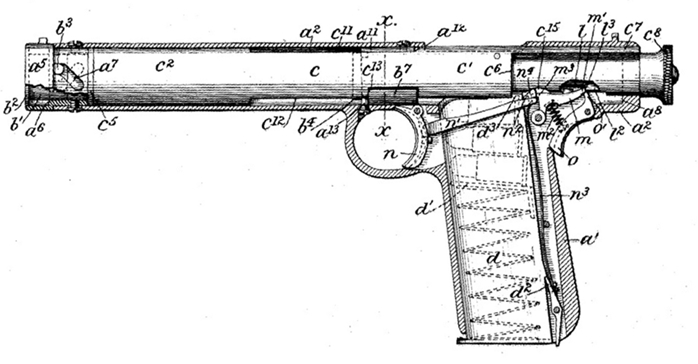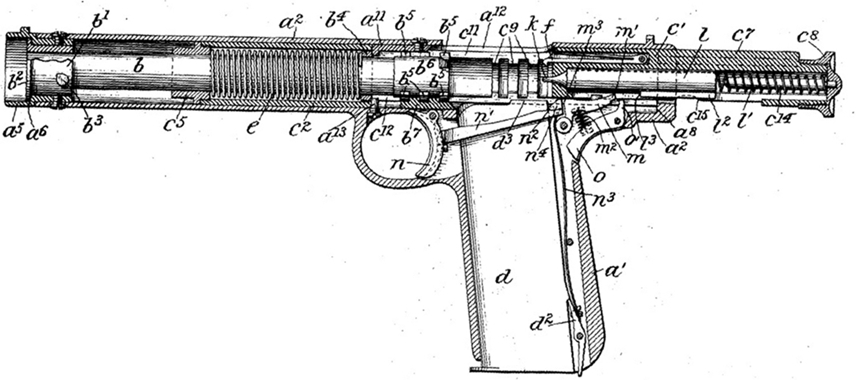In 1897, John M. Browning was awarded four consecutive patents, which covered a big swath of possible automatic pistol designs. The one we’re looking at today (pointed out to me by Rufus at SHOT – thanks!) is number 580,925, which pertains to a rotating-barrel lockup system. Yep, Browning patented that 15 years before the rotating-barrel Steyr went into production. It never went into production, but is definitely worth a look anyway.
Browning’s rotary design, unlike some of his other early pistols, has nice lines to it:

Unlike the Steyr 1912, this pistol did not use a modern-style slide. Instead, the shroud around the barrel was an integral part of the frame. It used a separate tubular slide assembly inside the shroud to affect rotation, with the barrel, equivalent in function to the slide on the Steyr. This inner tube (bolt carrier, really) held the locking lugs It used a pair of cams at the muzzle (A7 & B3) to control barrel rotation. The barrel and bolt carrier would stay locked together for the first bit of rearward motion (the precise distance required would have been determined through experimentation), and then the cammed grooves in the carrier would start to turn, unlocking it from the barrel.

The other features of the design were typical Browning – striker type firing pin, trigger wrapping around the magazine, grip safety, and even locking lugs that would blend right to other Browning designs. As a side note, it’s interesting to note that the design has no manual safety, just the grip safety. So why didn’t this go into production? I’m not sure – I don’t see any glaring problems, but I’m not an expert gunsmith by any stretch. My guess would be that Browning’s work with FN on the Model 1900 took up enough time that he just couldn’t pursue everything he had thought up.
Patents
US Patent 580,925 (John M Browning, “Firearm”, April 20, 1897)

That trigger/sear/grip safety linkage is a thing of beauty. (Although I haven’t been able to puzzle out how it disconnects from the drawing…)
Somebody should build some just for the hell of it. I think it’d be pretty cool to have.
From what I’ve come to understand from the patent, The reason why Browning never produced this firearm, was because it was meant to be an example model for improvements in the operation/action of firearms. In it he explains A process he referred to as “synchronous double movement”, more commonly referred to today as short recoil operation. Browning mentions in the patent that many of this firearm’s features are not limited to a firearm of any particular class or description. Also mentioned was the patent browning filed for before this one (No. 580,924) Browning says that this one is “subordinate” to that design. 580,924 went on to become the Colt M1900, which operates more or less the same, minus the rotary movement. So from what I can see, 924 was the patent for the firearm, while 925 was more or less filed so that even though others were welcomed to use it, he would be known as the creator of the new form of firearm’s action. (But like I said, it’s only what I gather from it, I could be missing something.)
Building this gun for the fun of it will cost someone $15,000.
stripping that thing would be a nightmare
Please be aware that someone did build an example of this pistol — Browning himself. A photo of the prototype, credited to the John M. Browning Armory, is included in the book “John M. Browning, American Gunmaker” by John Browning (JMB’s son) and Curt Gentry. This biography asserts that JMB tended to build his guns from scratch, either first constructing wooden models, or skipping that step to construct direct-from-metal shooting examples, and left the blueprint-drawing until after the prototype gun was proven to work. He allegedly offered this pistol to Colt, who preferred the drop-barrel lockup.
It is possible that the designers of the Roth-Sauer and Roth-Steyr 1907 acquired their patents coincidentally in ignorance of Browning’s design, or copied him without violating the patent. Browning may have known of the Schwarzlose Standardt pistol (also patented 1898), which had a short-recoil mechanism with a rotating bolt — I mention this only because Browning only designed long arms with the recoiling barrel and rotating bolt mechanism — and those were long-recoil designs.
This sear-trigger-grip safety linkup was repeated, I think, in the FN 1910 pistol, and combined with a manual safety and a magazine safety to boot. Clever multistasking, no?